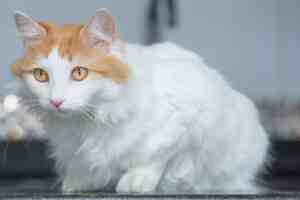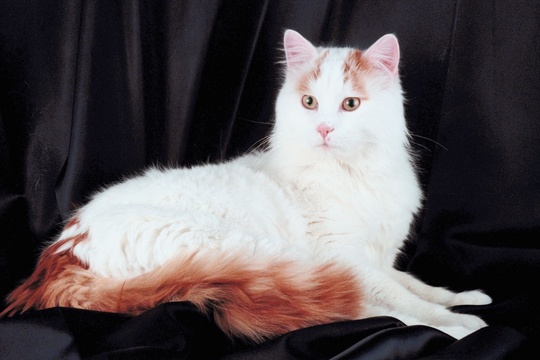Introduction to Turkish Van Cats: The Swimming Felines
Turkish Van Cats, often referred to as the “swimming cats,” are a unique breed known for their love of water. Unlike most felines, these cats are not only comfortable around water but also enjoy swimming. This unusual trait, combined with their striking appearance and playful nature, makes them a fascinating breed to explore.
The Turkish Van Cat is a natural breed from the Lake Van region of Turkey, hence its name. They are one of the oldest and most distinct cat breeds, with a history that dates back thousands of years. Their love for water, coupled with their distinctive markings, has earned them a special place in the world of felines.

The Origin and History of Turkish Van Cats
The Turkish Van Cat is believed to have originated in the Lake Van region of Turkey, hence its name. The breed has been around for centuries, with depictions of similar-looking cats found in artifacts dating back to the Middle Ages. They were brought to Europe in the 1950s by two British photographers, Laura Lushington and Sonia Halliday, who were given a pair of these cats while on a trip to Turkey.
The breed was officially recognized by The International Cat Association (TICA) in 1979 and by the Cat Fanciers’ Association (CFA) in 1988. Despite their long history, Turkish Van Cats are still relatively rare, especially outside of Turkey.
Physical Characteristics of Turkish Van Cats
Turkish Van Cats are medium to large-sized cats, with males typically weighing between 10-20 pounds and females between 7-12 pounds. They have a muscular build, with broad shoulders and a sturdy body. Their coat is semi-long and has a cashmere-like texture, which is water-resistant, another trait that contributes to their swimming ability.
The most distinctive feature of Turkish Van Cats is their color pattern, known as the “Van pattern.” This pattern is characterized by a white body with colored markings primarily on the head and tail. The colors can range from red to cream, black, blue, or tortoiseshell. They also have striking, almond-shaped eyes that can be blue, amber, or one of each color, a condition known as heterochromia.
The Unique Swimming Ability of Turkish Van Cats
What sets Turkish Van Cats apart from other breeds is their unique love for water. While most cats shy away from water, Turkish Vans are known to enjoy swimming. This trait is believed to have developed as a survival mechanism in their native region, where temperatures can get extremely high.
Their water-resistant coat allows them to swim without getting weighed down. They are known to dive into water bodies, paddle around, and even play fetch in the water. However, not all Turkish Vans will automatically take to water, and it’s essential not to force them if they show signs of discomfort.

Understanding the qBehavior and Temperament of Turkish Van Cats
Turkish Van Cats are known for their energetic and playful nature. They are intelligent and curious, often finding ways to entertain themselves. They are also known to be affectionate and form strong bonds with their human companions.
Despite their playful nature, Turkish Vans also value their independence. They can be aloof with strangers and may not be the best choice for families with young children or other pets. They are also known to be quite vocal and will not hesitate to express their needs or displeasure.
Health and Lifespan of Turkish Van Cats
Turkish Van Cats are generally healthy, with a lifespan of 12-17 years. However, like all breeds, they are prone to certain health conditions. These include hypertrophic cardiomyopathy (a form of heart disease), hip dysplasia, and obesity.
Regular vet check-ups and a balanced diet can help ensure your Turkish Van stays healthy. It’s also important to keep them mentally and physically stimulated, as they are an active breed.
Caring for a Turkish Van Cat: Diet, Exercise, and Grooming
Turkish Van Cats require a balanced diet to maintain their health and energy levels. High-quality cat food, both dry and wet, is recommended. They also need plenty of fresh water, especially if they are active swimmers.
Exercise is crucial for this breed, given their high energy levels. Play sessions, interactive toys, and even swimming can help keep them fit. As for grooming, their semi-long coat requires regular brushing to prevent matting. However, they do not need frequent baths, thanks to their water-resistant coat.
Training Your Turkish Van Cat to Swim
While Turkish Van Cats are natural swimmers, it’s important to introduce them to water gradually and in a safe environment. Start with shallow water and let them explore at their own pace. Never force them into the water, as it can create fear and aversion.
Ensure the water is warm, as cats are sensitive to cold temperatures. Also, always supervise your cat while they are in the water to prevent accidents.
Common Myths and Misconceptions about Turkish Van Cats
One common myth about Turkish Van Cats is that they are all avid swimmers. While the breed is known for its love of water, not all Turkish Vans enjoy swimming. Each cat is unique, and their preferences can vary.
Another misconception is that Turkish Vans are aggressive or aloof. While they value their independence, they are also known to be affectionate and form strong bonds with their human companions. They can be wary of strangers, but this does not make them aggressive.
Why Turkish Van Cats Make Great Pets: A Conclusion
Turkish Van Cats, with their unique swimming ability, striking appearance, and playful nature, make for fascinating pets. They are intelligent, curious, and form strong bonds with their human companions. While they require regular exercise and mental stimulation, they are generally easy to care for.
Their love for water can also add an extra layer of fun to pet ownership. Whether you’re watching them paddle around in a kiddie pool or joining them for a swim, Turkish Vans are sure to bring joy and excitement to your life. However, it’s important to remember that each cat is unique, and not all Turkish Vans will share the same traits or preferences.

